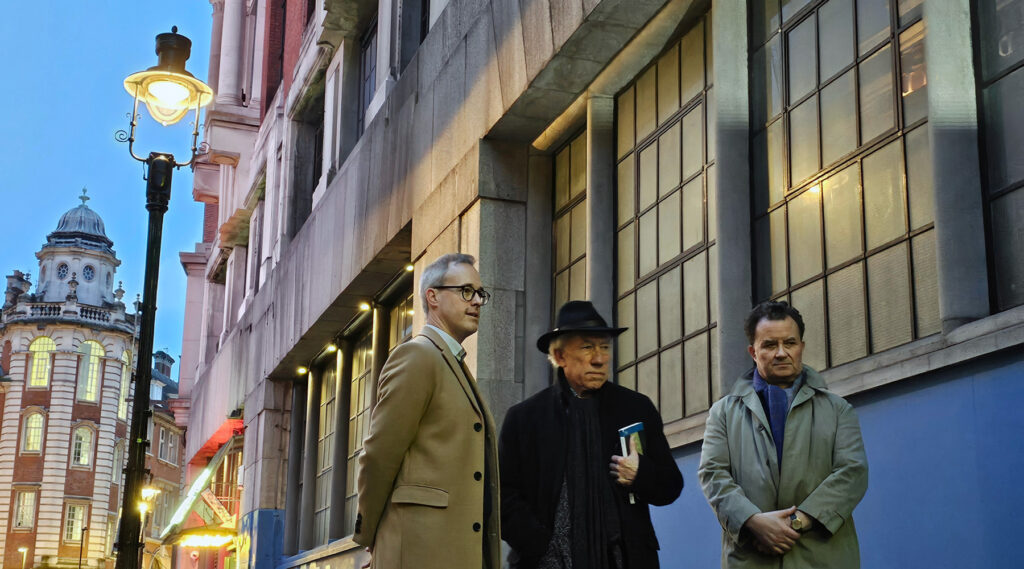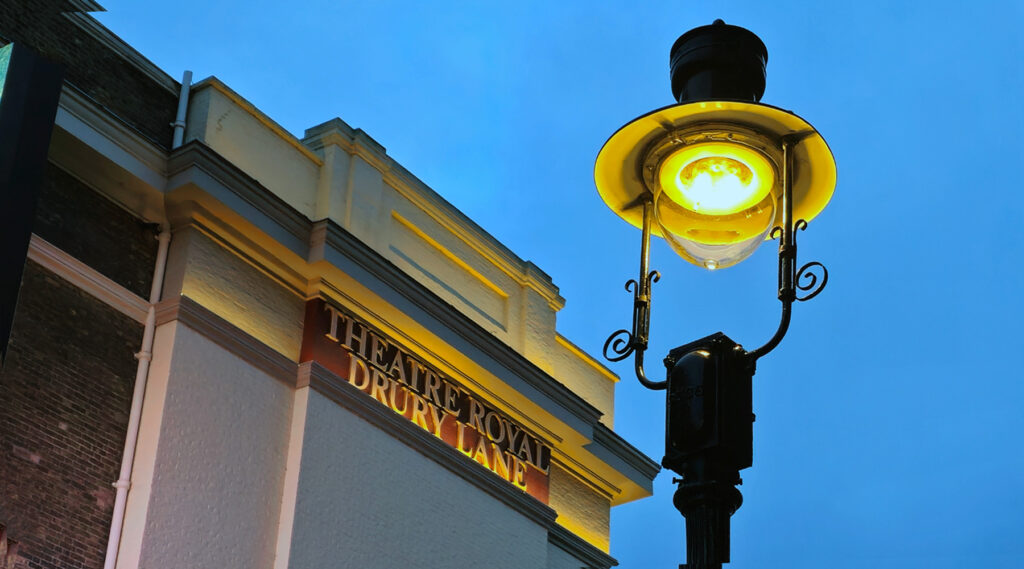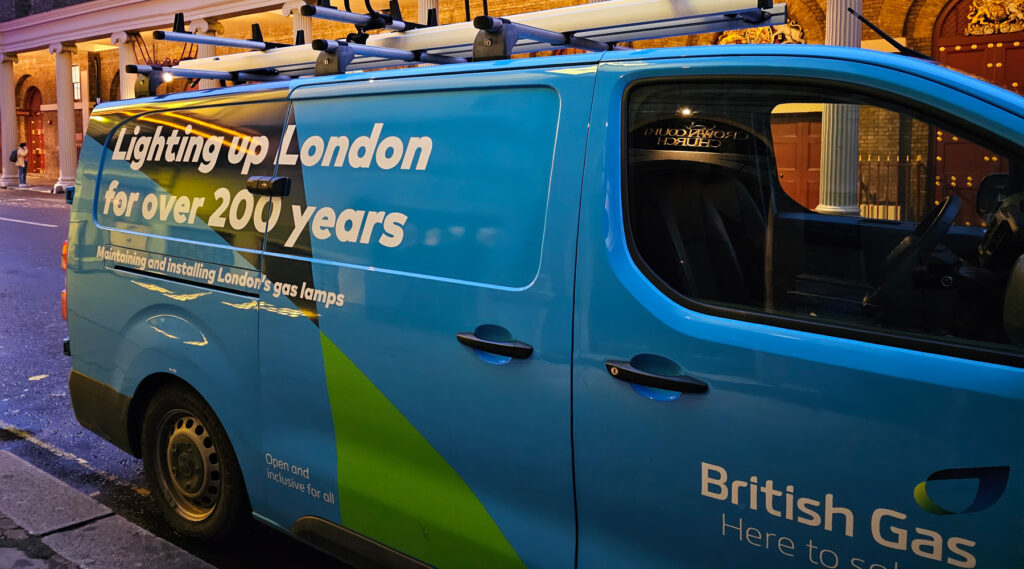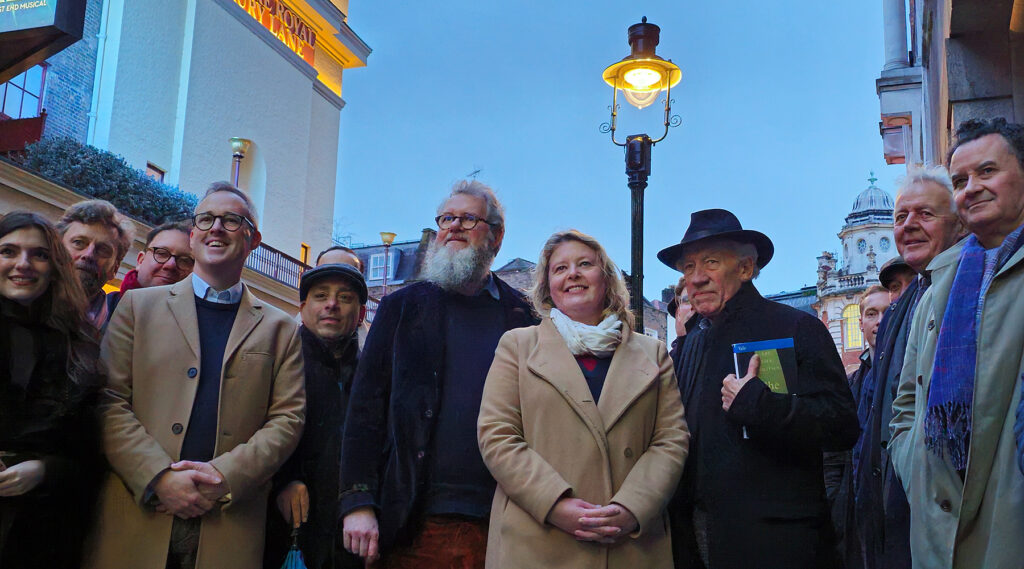Historic England has given four gas-powered street lamps that have been glowing in Covent Garden for over a century heritage listing protection, so they will continue to cast a warm glow in the streets.
The four gas lamps, in a cluster near the London Transport Museum, are part of a collection installed around Covent Garden in 1910 to mark the beginning of George V’s reign. They have been listed at Grade II due to a pilot project by Historic England to help inform ongoing discussions about the management of gas lamps in Westminster and beyond.
More lamps are expected to be given heritage protection in the future.

Arts and Heritage Minister Lord Parkinson, Actor Simon Callow and campaigner Luke Honey (c) ianVisits
Street lighting fuelled by gas began in London, and the first recorded demonstration worldwide of gas-powered street lamps was on Pall Mall in 1807. The earliest to arrive in Covent Garden was in 1820, when the Duke of Bedford commissioned a 20 feet tall stone column with a large gas lamp attached to the top.
Not that these new-fangled gas lamps were universally popular, with prints satirising public panics about the gas lamps killing people — a tendency to crazy paranoia about new things that humanity still hasn’t grown out of. Despite that, by 1823, public spaces across the country were lit by gas.
Although electrics have long supplanted them, there are still around 1,300 working gas lamps in London, with around 270 in Westminster, of which about half the Westminster lamps are currently listed.
The decision to give the lamps listed protection has been welcomed by Nickie Aiken, MP for the Cities of London and Westminster, the London Gasketeers, and the Victorian Society who have requested the protection of the capital’s early streetlighting.
Arts and Heritage Minister, Lord Parkinson of Whitley Bay, said: “London’s gas lamps have been an integral part of the city’s identity for more than two centuries. From the novels of Dickens and Conan-Doyle to Mary Poppins and The Muppet Christmas Carol, they have provided an evocative backdrop to many of our capital’s most cherished scenes and locations.”
Although the lamps were installed in 1910, the lanterns on top are from the 1930s in the “Upright Rochester” style, designed to reduce shadow and improve the distribution of light onto the street below.
The change in lantern isn’t unusual, as many surviving gas lamps are made up of columns, brackets and lanterns of different ages and styles. There are various standardised designs as well as now unique examples like the Grade II listed sewer gas destructor lamp on Carting Lane, near the Savoy.
There’s also a team of British Gas engineers who maintain the lamps, so look out for their vans in central London.
Tim Bryars, on behalf of the London Gasketeers, added: “We are especially pleased that the listing includes one of the more modern lamps, installed following the successful campaign to save historic Covent Garden from demolition and redevelopment in the 1970s. Campaigners who won that battle appreciated the value of preserving the lamps in chains and clusters, as we do. These are the first Westminster gas lamps to be listed in 40 years, a milestone in our grassroots campaign, and it provides a model for protecting the remaining handful of survivors.”
The newly listed gas lamps on the National Heritage List for England are at:
- Lamp post outside 4-6 Russell Street
- Lamp post outside 24 Russell Street
- Lamp post opposite Theatre Royal Drury Lane, outside 29 Russell Street
- Lamp post outside 34-43 Russell Street
Westminster council has committed to keep any gas lamps that are given listed status — although the others will be converted to LED lamps that superficially look like gas mantels but aren’t quite as warm as the gas lamps they replace.
Sadly, modern street lighting is often more about pumping out as much light as possible than decoratively illuminating an area. A massive glowing banner outside the theatre opposite almost obliterates the light from these newly listed gas lamps.
Alongside the campaign to save decorative gas street lighting, it would be good to see more action taken to use clever modern lighting to enhance a street rather than just illuminate it. Wouldn’t it be nice to have streets lit by gas lamps that can be admired against the decorative modern LED lights used to highlight the architecture of the buildings?










There’s three or four lovely ones on the street between Imperial College and the Science Museum in South Kenisngton too. I hope they are listed.
Makes me think about a scene in Only Fools and Horses where Del describes Grandad as an out of work lamp lighter waiting for gas to make a comeback.
I was given to understand that Westminster Council had approved retaining ALL the gas lighting within the area of “inner” Covent Garden, including Bedford Street and New Row? I hope this is correct?
I agree with Ian that street lighting could be more imaginatively used. Also, extremely bright commercial signage should be prohibited in areas which are even partly residential.
I agree with Lizebeth. I would also like to see an end to all electric scrolling adverts at busstops, on hoardings and on Tube escalators. A waste of electricity.